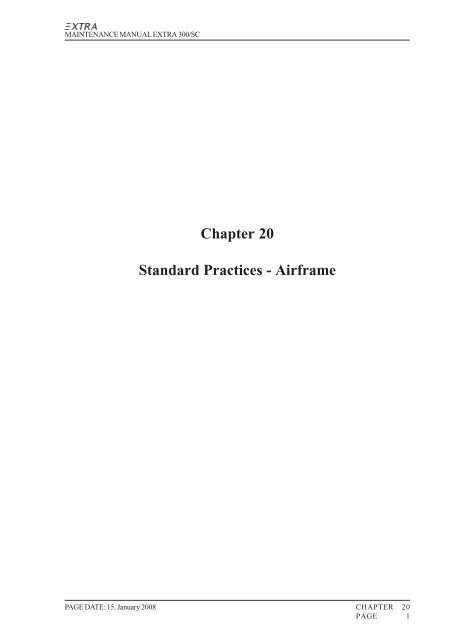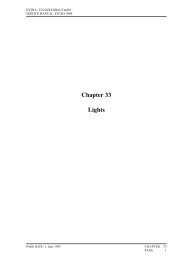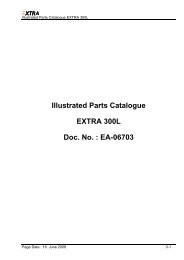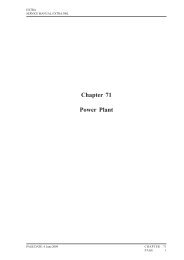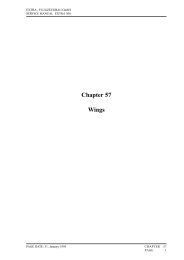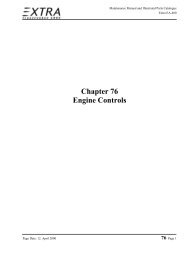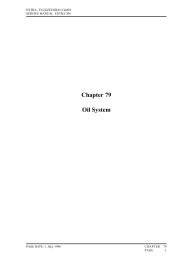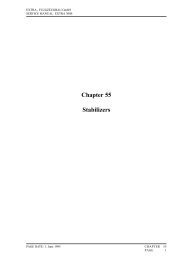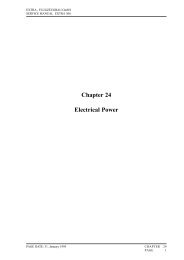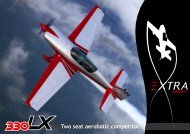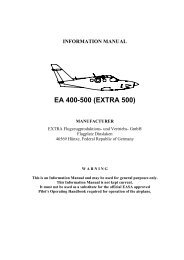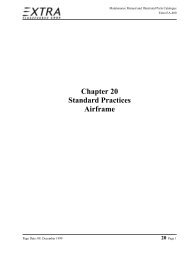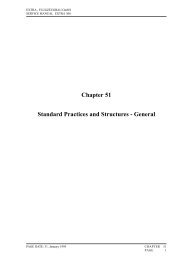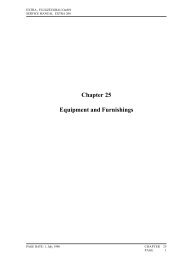Chapter 20 Standard Practices - Airframe - Extra Aircraft
Chapter 20 Standard Practices - Airframe - Extra Aircraft
Chapter 20 Standard Practices - Airframe - Extra Aircraft
Create successful ePaper yourself
Turn your PDF publications into a flip-book with our unique Google optimized e-Paper software.
MAINTENANCE MANUAL EXTRA 300/SC<br />
<strong>Chapter</strong> <strong>20</strong><br />
<strong>Standard</strong> <strong>Practices</strong> - <strong>Airframe</strong><br />
PAGE DATE: 15. January <strong>20</strong>08<br />
CHAPTER <strong>20</strong><br />
PAGE 1
MAINTENANCE MANUAL EXTRA 300/SC<br />
<strong>Chapter</strong> <strong>20</strong><br />
Table of Contents<br />
<strong>Chapter</strong><br />
Title<br />
<strong>20</strong>-00-00 GENERAL . . . . . . . . . . . . . . . . . . . . . . . . . . . . . . . . . . 3<br />
<strong>20</strong>-10-00 STANDARD PRACTICES AIRFRAME . . . . . . . . . . . 4<br />
<strong>20</strong>-10-01 Type of Bolts . . . . . . . . . . . . . . . . . . . . . . . . . . . . . . . . . 4<br />
<strong>20</strong>-10-02 Width Across Flats for Metric Bolts . . . . . . . . . . . . . . . 6<br />
<strong>20</strong>-10-03 Torque Values . . . . . . . . . . . . . . . . . . . . . . . . . . . . . . . . 7<br />
<strong>20</strong>-10-04 Special Torque Values . . . . . . . . . . . . . . . . . . . . . . . . . . 8<br />
<strong>20</strong>-10-05 Measuring Techniques . . . . . . . . . . . . . . . . . . . . . . . . . . 9<br />
<strong>20</strong>-10-06 Coin Tapping . . . . . . . . . . . . . . . . . . . . . . . . . . . . . . . . . 9<br />
<strong>20</strong>-10-07 Flexible Hose . . . . . . . . . . . . . . . . . . . . . . . . . . . . . . . 10<br />
<strong>20</strong>-10-08 Fittings . . . . . . . . . . . . . . . . . . . . . . . . . . . . . . . . . . . . 11<br />
<strong>20</strong>-<strong>20</strong>-00 ASSEMBLY INSTRUCTION . . . . . . . . . . . . . . . . . . 12<br />
<strong>20</strong>-<strong>20</strong>-01 General . . . . . . . . . . . . . . . . . . . . . . . . . . . . . . . . . . . . 12<br />
<strong>20</strong>-<strong>20</strong>-02 Assembly Instruction after Container Shipping . . . . . . 12<br />
PAGE DATE: 15. January <strong>20</strong>08<br />
CHAPTER <strong>20</strong><br />
PAGE 2
MAINTENANCE MANUAL EXTRA 300/SC<br />
<strong>20</strong>-00-00 GENERAL<br />
The design of the airframe is according to standard procedures<br />
and requires no special tools or procedures for maintenance.<br />
For that reason, only the bolts used in the<br />
EXTRA 300/SC with relevant torque values and measuring<br />
techniques are described in the following.<br />
PAGE DATE: 15. January <strong>20</strong>08<br />
CHAPTER <strong>20</strong><br />
PAGE 3
MAINTENANCE MANUAL EXTRA 300/SC<br />
<strong>20</strong>-10-00 STANDARD PRACTICES AIRFRAME<br />
<strong>20</strong>-10-01 Type of Bolts<br />
For the EXTRA 300/SC, LN-bolts (LN="Luftfahrt Norm"),<br />
AN-bolts (AN="Army/Navy") and DIN-bolts<br />
(DIN="Deutsche Industrie Norm") are used. The type of bolt<br />
can be identified by the designation on bolt head and by the<br />
surface treatment.<br />
LN-Bolts<br />
Hex head LN 9037, LN 9038 K and LN 9355 aircraft bolts<br />
are made of high-strength type 1.72<strong>20</strong>.5 alloy steel. The<br />
bolts are centerless ground, threaded after heat treatment<br />
and cadmium plated per specification LN 9368-3000.2.<br />
Bolts according LN 9037 are standard aircraft bolts with<br />
undrilled shank. The specification LN 9355 indicates bolts<br />
with shank drilled for cotter pin. The specification LN 9038<br />
K indicates bolts with drilled head for safety wire and a<br />
thread up to the head.<br />
The adding numbers after the dash of bolt spec. indicates the<br />
dimensions of the bolt. These numbers are not marked on the<br />
head of the LN bolt. Measure the diameter and length to<br />
specify the type dimension of the LN bolt. The length of LN<br />
aircraft bolt is measured from under the head to the end of<br />
the shank.<br />
Example: LN 9037-08042<br />
Bolt Head Identification<br />
Bolt Head:<br />
LN Specification<br />
Metric thread size (M8=8 mm)<br />
and Lenght (042=42mm/<br />
1.65 inch)<br />
Letter (R,L,P,H = Identification of<br />
Manufacturer)<br />
PAGE DATE: 15. January <strong>20</strong>08<br />
CHAPTER <strong>20</strong><br />
PAGE 4
MAINTENANCE MANUAL EXTRA 300/SC<br />
STANDARD PRACTICES AIRFRAME<br />
Type of Bolts<br />
AN-Bolts<br />
Hex head AN aircraft bolts are made of high-strength type<br />
4037 or 8740 alloy steel. The bolts are centerless ground,<br />
threaded after heat treatment and cadmium plated per specification<br />
QQ-P-416A, Type II, Class 3.<br />
For the EXTRA 300/SC bolts with shank drilled for cotter<br />
pin or drilled head for safety wire are used. The adding letter<br />
"A" after the dash number specifies bolts with undrilled<br />
shank. For bolts with drilled head a letter "H" is added after<br />
the AN number. The length of AN aircraft bolts is measured<br />
from under the head to the end of the shank.<br />
Example: AN 3 - 5A<br />
Bolt Head Identification AN hex head bolt<br />
Diameter 3 / 16<br />
" (4.8 mm) Length 5 / 8<br />
" (15.9 mm)<br />
Undrilled shank<br />
Letter (Identification of Manufacturer,<br />
not always given.)<br />
Cross (Alloy Steel)<br />
Letter (also adjected)<br />
DIN-Bolts<br />
Hex head DIN 931, DIN 933 and hex socket head DIN 912<br />
bolts are standard bolts made of steel with undrilled shank.<br />
The surface treatment is chromatized yellow.<br />
Unlike the DIN 931 and DIN 912 the thread of a DIN 933 bolt<br />
goes up to the head. The numerical code shown on the head<br />
of a DIN bolt specifies the strength type. Also, most bolts<br />
will bear a wide variety of finitials or symbols which identify<br />
the manufacturer. Measure the diameter and length to specify<br />
the type dimension of the DIN bolt. The length of DIN bolt<br />
is measured from under the head to the end of the shank.<br />
PAGE DATE: 15. January <strong>20</strong>08<br />
CHAPTER <strong>20</strong><br />
PAGE 5
MAINTENANCE MANUAL EXTRA 300/SC<br />
STANDARD PRACTICES AIRFRAME<br />
Type of Bolts<br />
Example: DIN 931, M10 x 80 - 8.8<br />
Bolt Head Identification<br />
Bolt Head:<br />
<strong>Standard</strong> hex head bolt<br />
Metric thread size M10<br />
Length 80mm (3.15")<br />
Strength type 8.8<br />
DIN 931: DIN 933:<br />
Identification of<br />
manufacturer (OEV)<br />
Strength type<br />
(8.8 resp.12.9)<br />
<strong>20</strong>-10-02 Width Across Flats for Metric Bolts<br />
Thread diameter<br />
M4<br />
M5<br />
M6<br />
M8<br />
M10<br />
M12<br />
M16<br />
M<strong>20</strong><br />
M24<br />
Width across flats<br />
7 mm<br />
8 mm<br />
10 mm<br />
13 mm<br />
17 mm<br />
19 mm<br />
24 mm<br />
30 mm<br />
36mm<br />
PAGE DATE: 15. January <strong>20</strong>08<br />
CHAPTER <strong>20</strong><br />
PAGE 6
MAINTENANCE MANUAL EXTRA 300/SC<br />
STANDARD PRACTICES AIRFRAME<br />
<strong>20</strong>-10-03 Torque Values<br />
Nuts, except of counter nuts are mainly stop nuts according<br />
to LN 9348 or selflocking nuts according to AN 363.<br />
a) <strong>Standard</strong> torque values allowed for bolts and nuts according<br />
to DIN and LN must be adhered to as follows:<br />
Metric thread size<br />
Torque value<br />
(Nm)<br />
(in.lbs)<br />
Torque value<br />
M4 1,8 16<br />
M5 3.9-4.3 35-38<br />
M6 6.2-6.8 55-60<br />
M8 15.2-16.8 144-148<br />
M10 29.5-32.5 261-287<br />
M12x1.5 51-57 452-504<br />
b) <strong>Standard</strong> torque values allowed for bolts and nuts according<br />
to AN and MS must be adhered to as follows:<br />
Thread Size<br />
Torque Value<br />
(Nm)<br />
(in.lbs)<br />
1/4-28 3.4 - 4.5 30 - 40<br />
5/16-24 6.7 - 9.5 60 - 85<br />
3/8-24 10.7 - 12.5 95 - 110<br />
7/16-<strong>20</strong> 30.5 - 33.9 270 - 300<br />
1/2-<strong>20</strong> 32.8 - 46.3 290 - 410<br />
9/16-18 88.1 - 67.8 480 - 600<br />
I M P O R T A N T<br />
On all bolt connections, the specified torque and locking<br />
method must be observed. Do not reuse stop nuts if<br />
they can be run up finger tight!<br />
PAGE DATE: 15. January <strong>20</strong>08<br />
CHAPTER <strong>20</strong><br />
PAGE 7
MAINTENANCE MANUAL EXTRA 300/SC<br />
STANDARD PRACTICES AIRFRAME<br />
<strong>20</strong>-10-04 Special Torque Values<br />
Adhere to the special torque values for the following items:<br />
Item<br />
Engine Mounting<br />
(Bolts AN7-50A / Metal Stop Nut NAS<br />
363C-7<strong>20</strong>)<br />
Engine Mount to Fuselage<br />
(Bolt Din 912, M12-12.9 / Stop Nut DIN<br />
985, M12-8-B2C)<br />
Longeron Cutout Bridge<br />
(Upper Bolts DIN 912 M8-8.8 / Stop Nut<br />
LN 9348-08)<br />
(Lower Bolt DIN 912 M10x230 / Stop Nut<br />
LN 9348-10)<br />
Horizontal Stabilizer Front Spar Bolts (Bolt<br />
LN 9037-10054 / Stop Nut LN 9348-10)<br />
Horizontal Stabilizer Rear Spar Bolts (Bolt<br />
LN 9037-10050 / Stop Nut LN 9348-10)<br />
Vertical Stabilizer Rear Spar Bolt (Bolt LN<br />
9037-10054 / Stop Nut LN 9348-10)<br />
Wing Main Spar Safety-Bolts<br />
(Bolt LN 9038 K-080<strong>20</strong>)<br />
Brake Back Plate Bolts (Cleveland)<br />
Wheel Assembly Bolts (Cleveland)<br />
Torque for Engine<br />
Torque for Propeller<br />
Torque value<br />
(Nm)<br />
(in.lbs)<br />
55 480<br />
80 7<strong>20</strong><br />
18<br />
33<br />
160<br />
292<br />
33 292<br />
33 292<br />
38 336<br />
15 133<br />
Refer to<br />
Cleveland<br />
Maintenance<br />
Manual<br />
Refer to<br />
Lycoming<br />
Overhaul Manual<br />
See MTpropeller<br />
Installation<br />
Manual E-124<br />
I M P O R T A N T<br />
On all bolt connections, the specified torque and locking<br />
method must be observed. Do not reuse stop nuts if<br />
they can be run up finger tight!<br />
PAGE DATE: 15. January <strong>20</strong>08<br />
CHAPTER <strong>20</strong><br />
PAGE 8
MAINTENANCE MANUAL EXTRA 300/SC<br />
STANDARD PRACTICES AIRFRAME<br />
<strong>20</strong>-10-05 Measuring Techniques<br />
When using stop nuts, the safety torque (friction torque or<br />
braking torque) should be added to the table standard values.<br />
This value is indicated on the dial of the torquemeter, before<br />
the nut contacts the attachment surface.<br />
Always torque nuts for fastening, if possible. When bolts are<br />
torqued there might be an additional torque value due to shaft<br />
friction. This torque can be determined by a torquemeter<br />
before the bolt head contacts the attachment surface and<br />
should be added to the table value.<br />
<strong>20</strong>-10-06 Coin Tapping<br />
Inspection for damage is more critical for composite structure<br />
than for conventional structures. A large washer or<br />
similar object is a valuable tool for detecting debonds in the<br />
airframe surface. When a large washer is lightly bounced<br />
against a solid structure, a clear metallic ring should be<br />
heard. If delamination is present, a dull thud will be heard.<br />
This procedure is shown in the following Figure 1:<br />
Coin Tapping<br />
Figure 1<br />
PAGE DATE: 15. January <strong>20</strong>08<br />
CHAPTER <strong>20</strong><br />
PAGE 9
MAINTENANCE MANUAL EXTRA 300/SC<br />
STANDARD PRACTICES AIRFRAME<br />
<strong>20</strong>-10-07 Flexible Hose<br />
The following oil, fuel, brake and sense lines are installed in<br />
the EXTRA 300/SC:<br />
Fuel, oil and sense lines<br />
in engine compartment<br />
Fuel lines<br />
in cabin compartment<br />
Brake lines<br />
Parker/Stratoflex<br />
PTFE Type 101<br />
Parker/Stratoflex<br />
PTFE Type 124<br />
Knapp/Hoerbiger<br />
HS3AM and H3MM<br />
Maintenance work or overhaul of these hoses requires the<br />
attention of the manufacturer informations and bulletins.<br />
For the replacement of hose and hose assemblies the<br />
EXTRA-Flugzeugproduktions- und Vertriebs- GmbH<br />
should be contacted.<br />
Replacement of Flexible Hose<br />
Hose and hose assemblies should be checked for deterioration<br />
at each inspection period. Leakage, separation of the<br />
cover or braid from the inner tube, cracks, hardening, lack of<br />
flexibility, and excessive "cold flow" are apparent sign of<br />
deterioation and reason for replacement. The term "cold<br />
flow" describes the deep, permanent impressions in the hose<br />
produced by pressure of hose clamps or supports.<br />
The entire assembly must be replaced, if failure occurs in a<br />
flexible hose before the timelimit (refer to <strong>Chapter</strong> 05-10-<br />
02 Overhaul Schedule) of the hose is achieved. Obtain a<br />
new hose assembly of the correct size and length, complete<br />
with factory-installed end fittings.<br />
Installation of Flexible Hose Assemblies<br />
The flexible hose must not be twisted on installation, since<br />
this reduces the life of the hose considerably and may be<br />
loosen the fittings. Twisting of the hose can be determined<br />
from the identification stripe running along its length.<br />
PAGE DATE: 15. January <strong>20</strong>08<br />
CHAPTER <strong>20</strong><br />
PAGE 10
MAINTENANCE MANUAL EXTRA 300/SC<br />
STANDARD PRACTICES AIRFRAME<br />
Flexible Hose<br />
The minimum bend radius for flexible hose varies according<br />
to size and construction of the hose and the pressure under<br />
which the hose is to operate. Bends that are too sharp will<br />
reduce the bursting pressure of flexible hose considerably<br />
below its rated value.<br />
The flexible hose should be installed so that it will be subject<br />
to a minimum of flexing during operation.<br />
<strong>20</strong>-10-08 Fittings<br />
For the oil lubrication, the fuel system, and the brake system<br />
only AN-fittings are used in the EXTRA 300/SC. All these<br />
fittings are made of aluminium alloy and are colored blue for<br />
identification purposes. The dash number following the AN<br />
number indicates the size of the hose for which the fitting is<br />
made, in 16ths of an inch. This size measures the inner<br />
diameter (I.D.) of the hose. The material code letter<br />
(Aluminum alloy: code D) follows the dash number.<br />
Example: Elbow AN 822-8D<br />
N O T E<br />
Apply Loctite 577 on all National Pipe Threads (NPT)<br />
before installation.<br />
PAGE DATE: 15. January <strong>20</strong>08<br />
CHAPTER <strong>20</strong><br />
PAGE 11
MAINTENANCE MANUAL EXTRA 300/SC<br />
<strong>20</strong>-<strong>20</strong>-00 ASSEMBLY INSTRUCTION<br />
<strong>20</strong>-<strong>20</strong>-01 General<br />
N O T E<br />
Make appropriate logbook entry of compliance with<br />
this Assembly Instruction after Container Shipping.<br />
In case of the aircraft is delivered in a container it has to be<br />
assembled on arrival.<br />
For assembly of aircraft main components follow the instructions<br />
as outlined in the <strong>Chapter</strong> <strong>20</strong>-<strong>20</strong>-02.<br />
These instructions can not replace the skill, craftsmanship<br />
and sound technical knowledge of qualified personnel. In<br />
case of doubt or lack of information, the manufacturer of the<br />
respective component should be contacted for advice.<br />
Unless otherwise specified all bolts and connections should<br />
be torqued as listed in <strong>Chapter</strong> <strong>20</strong>-10-03. At some locations<br />
special torque values considered necessary. Refer to <strong>Chapter</strong><br />
<strong>20</strong>-10-04. The stated direction "Front" and "Rear" are to<br />
be considered in respect of pilot`s seating direction.<br />
<strong>20</strong>-<strong>20</strong>-02 Assembly Instruction after Container<br />
Shipping<br />
Complete each step of the assembly procedure in the order<br />
shown below.<br />
1 Check the condition of fastening of the aircraft components<br />
in the container. Note any damage.<br />
2 Remove the fuselage/engine assembly from the container.<br />
Prevent the aircraft from nosing over by keeping<br />
down the tail.<br />
3 Weight the tail per <strong>Chapter</strong> 07.<br />
PAGE DATE: 15. January <strong>20</strong>08<br />
CHAPTER <strong>20</strong><br />
PAGE 12
MAINTENANCE MANUAL EXTRA 300/SC<br />
ASSEMBLY INSTRUCTION<br />
Assembly Instruction after Container Shipping<br />
4 Remove the aircraft components out of the container.<br />
Small parts, hardware, spinner dome and the wheel<br />
fairings you find in the cockpit.<br />
5 Inspect all removed items for damage prior to assembly.<br />
Damaged items have to be replaced or if possible<br />
repaired according to <strong>Chapter</strong> 51.<br />
C A U T I O N<br />
In order to prevent the aircraft from nosing over the<br />
assembly has always to start with the empennage.<br />
6 Prior to assembly remove engine cowling, main fuselage<br />
cover, and canopy per <strong>Chapter</strong>s 51 and 53.<br />
N O T E<br />
In contrast to the instructions given in the respective<br />
<strong>Chapter</strong>s don‘t reinstall these items before completion<br />
of the whole assembly.<br />
7 Remove provisional attached rudder and vertical stabilizer<br />
per <strong>Chapter</strong>s 27 and 55.<br />
8 Install horizontal stabilizer with elevator per <strong>Chapter</strong> 55.<br />
The procedure described there is also applicable to the<br />
installation of the complete horizontal tail. Consider to<br />
connect the ground bonding lead of the elevator too.<br />
9 Connect elevator push pull rod actuator lever per <strong>Chapter</strong><br />
27-01-01.<br />
10 Connect trim wire to the tab actuator lever using fitted<br />
clamp.<br />
11 Inspect for full travel and elevator deflection in relation<br />
to stick movement.<br />
12 Install the vertical stabilizer per <strong>Chapter</strong> 55.<br />
13 Reinstall rudder to the vertical stabilizer per <strong>Chapter</strong><br />
27-21-01.<br />
14 Inspect for full travel and rudder deflection in relation<br />
to rudder pedal movement.<br />
15 Install the wing per <strong>Chapter</strong> 57.<br />
16 Install navigation/strobe lights per <strong>Chapter</strong> 33-41-01.<br />
17 Install propeller in accordance with MT-Propeller installation<br />
instructions E-124 latest revision.<br />
PAGE DATE: 15. January <strong>20</strong>08<br />
CHAPTER <strong>20</strong><br />
PAGE 13
MAINTENANCE MANUAL EXTRA 300/SC<br />
ASSEMBLY INSTRUCTION<br />
Assembly Instruction after Container Shipping<br />
18 Remove tail weight.<br />
19 Check if all switches are in Off-position and connect<br />
battery.<br />
22 Perform operational check of electrical equipment.<br />
21 Inspect trim tab for full travel and deflection in relation<br />
to the trim indication.<br />
22 Shut-off master switch after completion.<br />
23 Perform operational check and rigging of control system.<br />
24 Inspect fluid filled lines for leaks.<br />
25 Check security of main spar bolts.<br />
26 Install wheel fairings, main fuselage cover and rear support<br />
angle, canopy, engine cowlings, and access panels<br />
(Refer to <strong>Chapter</strong> 51-00-01 and 53).<br />
27 Check all control surfaces for freedom of movement<br />
and security.<br />
28 Perform a compass compensation according to „<strong>Aircraft</strong><br />
Inspection and Repair FAA AC 43.13“.<br />
29 Check correct servicing of aircraft.<br />
30 Perform an engine run up. Refer to <strong>Chapter</strong> "05-<strong>20</strong>-04<br />
Scheduled Maintenance Checks". Start the engine in<br />
accordance with the Pilot’s Operating Handbook and<br />
Airplane Flight Manual (POH).<br />
31 Inspect aircraft for foreign objects.<br />
32 Final inspection by licensed aircraft inspector.<br />
I M P O R T A N T<br />
After first flight check fuselage interior/exterior for<br />
fuel leaks. Check all bolts on fairings and cover sheets<br />
for tight fit.<br />
PAGE DATE: 15. January <strong>20</strong>08<br />
CHAPTER <strong>20</strong><br />
PAGE 14


